Investigation of the Long-Term Trends in the Streamflow Due to Climate Change and Urbanization for a Great Lakes Watershed
Abstract
1. Introduction
2. Materials and Methods
2.1. Study Area
2.2. Data Used
2.3. Population, Land-Cover and Land-Use Information
2.4. Statistical Analysis
3. Results and Discussion
3.1. Preliminary Inferences regarding the Data
3.2. Spatio-Temporal Changes in Climate Variables
3.3. Spatio-Temporal Changes in the Streamflow
3.4. Spatial Analysis between Rural and Urban Stream Gauges
4. Conclusions
- The analysis of the annual mean temperature and precipitation showed significant trends; however, evapotranspiration showed no such trends. The rural gauges tended to show increasing monthly and seasonal trends for precipitation, whereas the urban gauges tended to show increasing trends for temperature. Of the total 85 datasets, 82% of the datasets showed an increasing trend and 18% showed a decreasing trend. Out of these, 33 datasets showed a significant increasing trend and five datasets showed a significant decreasing trend. Over a ten-year period, the COV shifted three days earlier, showing that the fraction of streamflow happening each month was changing, driven by warming winter temperatures.
- Both the streamflow and baseflow showed trends. Out of the total 110 datasets, 78% of the datasets showed an increasing trend and 28% showed a decreasing trend. Out of these, 30 datasets showed a significant increasing trend, and one showed a significant decreasing trend. The FDC derivative—10% exceedance, which was used to detect the lateral shifts in the streamflow—did not show any consistent increase/decrease in values; however, the 10:90 exceedance ratio declined over the years but did not show any consistent change in its summer or autumn values.
- The BFI index varied during the latter two periods (Periods D and E). In general, if BFI > 0.5, the watershed could be deemed to have a slow response. The stationarity test was failed for the POT analysis. Though the magnitude of the likelihood of a flood changed, this change showed no clear pattern. At the same time, the flood and low flow frequencies decreased and increased, respectively. This change in the latter period, highlighting the fact that the annual peak declined over the years, at the same time as the annual seven-day minimum increased. The runoff coefficient showed a consistent behavior for the winter, spring, and autumn periods, where evapotranspiration was not a dominating factor. This implies that land use has played a significant role in the watershed’s hydrology for urban regions.
- A spatial analysis of both rural and urban gauges was used to attribute changes in streamflow to temperature and/or precipitation, which showed that rural zones were more sensitive to temperature and precipitation than urban zones. The same was the case for BFI. Out of the total 35 datasets, 86% showed an increasing trend and 14% showed a decreasing trend. Out of these, 12 datasets showed a significant increasing trend, and none showed a significant decreasing trend.
Supplementary Materials
Author Contributions
Funding
Institutional Review Board Statement
Informed Consent Statement
Data Availability Statement
Conflicts of Interest
References
- Bush, E.; Lemmen, D.S. Canada’s Changing Climate Report; Government of Canada: Ottawa, ON, Canada, 2019; p. 444. Available online: https://changingclimate.ca/site/assets/uploads/sites/2/2020/06/CCCR_FULLREPORT-EN-FINAL.pdf (accessed on 22 October 2021).
- Reidmiller, D.R.; Avery, C.W.; Easterling, D.R.; Kunkel, K.E.; Lewis, K.L.M.; Maycock, T.K.; Stewart, B.C. USGCRP Impacts, Risks, and Adaptation in the United States: Fourth National Climate Assessment, Volume II; U.S. Global Change Research Program: Washington, DC, USA, 2018; p. 1515. [CrossRef]
- Mailhot, E.; Music, B.; Nadeau, D.F.; Frigon, A.; Turcotte, R. Assessment of the Laurentian Great Lakes’ hydrological conditions in a changing climate. Clim. Chang. 2019, 157, 243–259. [Google Scholar] [CrossRef]
- Houghton, E.; Meiro Filho, L.G.; Callander, B.A.; Harris, N.; Kattenburg, A.; Maskell, K. Climate Change 1995: The Science of Climate Change: Contribution of Working Group I to the Second Assessment Report of the Intergovernmental Panel on Climate Change; Cambridge University Press: Cambridge, UK, 1996; Available online: https://digitallibrary.un.org/record/223181?ln=en (accessed on 22 October 2021).
- Egerton, F.N. History of Ecological Sciences, Part 60: American Great Lakes before. Bull. Ecol. Soc. Am. 2018, 99, 77–136. [Google Scholar] [CrossRef]
- Scott, R.W.; Huff, F.A. Impacts of the Great Lakes on Regional Climate Conditions. J. Great Lakes Res. 1996, 22, 845–863. [Google Scholar] [CrossRef]
- Wuebbles, D.; Cardinale, B.; Cherkauer, K.; Davidson-Arnott, R.; Hellmann, J.J.; Infante, D.; Johnson, L.; de Loë, R.; Lofgren, B.; Packman, A.; et al. An Assessment of the Impacts of Climate Change on the Great Lakes; The Environmental Law & Policy Center and the Chicago Council on Global Affairs: Chicago, IL, USA, 2019. Available online: https://www.climatehubs.usda.gov/sites/default/files/Great-Lakes-Climate-Change-Report.pdf (accessed on 22 October 2021).
- Ahmed, S.I.; Rudra, R.; Dickinson, T.; Ahmed, M. Trend and Periodicity of Temperature Time Series in Ontario. Am. J. Clim. Chang. 2014, 3, 272–288. [Google Scholar] [CrossRef]
- Adamowski, K.; Bougadis, J. Detection of trends in annual extreme rainfall. Hydrol. Process. 2003, 17, 3547–3560. [Google Scholar] [CrossRef]
- Rudra, R.P.; Dickinson, W.T.; Ahmed, S.I.; Patel, P.; Zhou, J.; Gharabaghi, B.; Khan, A.A. Changes in Rainfall Extremes in Ontario. Int. J. Environ. Res. 2015, 9, 1117–1126. [Google Scholar] [CrossRef]
- Champagne, O.; Arain, M.A.; Coulibaly, P. Atmospheric circulation amplifies shift of winter streamflow in southern Ontario. J. Hydrol. 2019, 578, 124051. [Google Scholar] [CrossRef]
- Champagne, O.; Arain, M.A.; Leduc, M.; Coulibaly, P.; McKenzie, S. Future shift in winter streamflow modulated by the internal variability of climate in southern Ontario. Hydrol. Earth Syst. Sci. 2020, 24, 3077–3096. [Google Scholar] [CrossRef]
- Singh, A.; Dougherty, J.; Zimmer, C.; Kinkead, J.; Hulley, M.; Doherty, C. Assessing Trends in Temperature, Precipitation and Streamflow due to Climate Change in Credit River Watershed. In Proceedings of the CCTC 2009: 2nd Climate Change Technology Conference, Hamilton, ON, Canada, 12–15 May 2009. [Google Scholar]
- Taylor, C.H.; Roth, D.M. Effects of suburban construction on runoff contributing zones in a small southern Ontario drainage basin. Hydrol. Sci. Bull. 1979, 24, 289–301. [Google Scholar] [CrossRef][Green Version]
- Ko, C.; Cheng, Q. GIS spatial modeling of river flow and precipitation in the Oak Ridges Moraine area, Ontario. Comput. Geosci. 2004, 30, 379–389. [Google Scholar] [CrossRef]
- Morgan, A.; Branfireun, B.; Csillag, F. An Evaluation of the Contributions of Urbanization and Climatic Change to Runoff Characteristics in the Laurel Creek Watershed, Ontario. Can. Water Resour. J. 2004, 29, 171–182. [Google Scholar] [CrossRef][Green Version]
- Muñoz, L.A.; Olivera, F.; Giglio, M.; Berke, P. The impact of urbanization on the streamflows and the 100-year floodplain extent of the Sims Bayou in Houston, Texas. Int. J. River Basin Manag. 2017, 16, 61–69. [Google Scholar] [CrossRef]
- Song, X.; Zhang, J.; Agha Kouchak, A.; Roy, S.S.; Xuan, Y.; Wang, G.; He, R.; Wang, X.; Liu, C. Rapid urbanization and changes in spatiotemporal characteristics of precipitation in Beijing metropolitan area. J. Geophys. Res. Atmos. 2014, 119, 11–250. [Google Scholar] [CrossRef]
- Whitney, J.W.; Glancy, P.A.; Buckingham, S.E.; Ehrenberg, A.C. Effects of rapid urbanization on streamflow, erosion, and sedimentation in a desert stream in the American Southwest. Anthropocene 2015, 10, 29–42. [Google Scholar] [CrossRef]
- Cunderlik, J.M.; Simonovic, S.P. Hydrological extremes in a southwestern Ontario river basin under future climate conditions/Extrêmes hydrologiques dans un basin versant du sud-ouest de l’Ontario sous conditions climatiques futures. Hydrol. Sci. J. 2005, 50, 1–654. [Google Scholar] [CrossRef]
- Konrad, C.P.; Booth, D.; Burges, S.J. Effects of urban development in the Puget Lowland, Washington, on interannual streamflow patterns: Consequences for channel form and streambed disturbance. Water Resour. Res. 2005, 41, 07009. [Google Scholar] [CrossRef]
- Martin, E.H.; Kelleher, C.; Wagener, T. Has urbanization changed ecological streamflow characteristics in Maine (USA)? Hydrol. Sci. J. 2012, 57, 1337–1354. [Google Scholar] [CrossRef]
- Zeng, F.; Ma, M.-G.; Di, D.-R.; Shi, W.-Y. Separating the Impacts of Climate Change and Human Activities on Runoff: A Review of Method and Application. Water 2020, 12, 2201. [Google Scholar] [CrossRef]
- CVC (Credit Valley Conservation). Strategic Plan, Final Version. 2007. Available online: https://cvc.ca/wp-content/uploads/2011/10/CVC-Strategic-Plan06.pdf (accessed on 22 October 2021).
- OMNRF (Ontario Ministry of Natural Resources and Forestry (MNRF). Infilled Climate Data. 2007. Available online: https://data.ontario.ca/dataset/in-filled-climate-data (accessed on 22 October 2021).
- NASA Earth Data. Giovanni Ver. 4. Available online: https://giovanni.gsfc.nasa.gov/giovanni/ (accessed on 22 October 2021).
- Ontario Ministry of Northern Development, Mines, Natural Resources and Forestry (MNRF). Ontario Flow Assesment Tool (OFAT). 2012. Available online: http://www.gisapplication.lrc.gov.on.ca/webapps/OFAT/Viewer/Viewer.html?lang=en-US (accessed on 22 October 2021).
- Trudeau, M.; Richardson, M. Change in event-scale hydrologic response in two urbanizing watersheds of the Great Lakes St Lawrence Basin 1969–2010. J. Hydrol. 2015, 523, 650–662. [Google Scholar] [CrossRef]
- Trudeau, M.; Richardson, M. Empirical assessment of effects of urbanization on event flow hydrology in watersheds of Canada’s Great Lakes-St Lawrence basin. J. Hydrol. 2016, 541, 1456–1474. [Google Scholar] [CrossRef]
- Whitfield, P.H.; Cannon, A.J. Recent Variations in Climate and Hydrology in Canada. Can. Water Resour. J. Rev. 2000, 25, 19–65. [Google Scholar] [CrossRef]
- Government of Canada, Natural Resources Canada, Canada Centre for Remote Sensing. Landsat Satellite Data, Land Cover of Canada-Cartographic Product Collection. Available online: https://open.canada.ca/data/en/dataset/11990a35-912e-4002-b197-d57dd88836d7 (accessed on 27 December 2021).
- Ashraf, M.S.; Ahmad, I.; Khan, N.M.; Zhang, F.; Bilal, A.; Guo, J. Streamflow Variations in Monthly, Seasonal, Annual and Extreme Values Using Mann-Kendall, Spearmen’s Rho and Innovative Trend Analysis. Water Resour. Manag. 2021, 35, 243–261. [Google Scholar] [CrossRef]
- Chen, Y.; Guan, Y.; Shao, G.; Zhang, D. Investigating Trends in Streamflow and Precipitation in Huangfuchuan Basin with Wavelet Analysis and the Mann-Kendall Test. Water 2016, 8, 77. [Google Scholar] [CrossRef]
- Norton, P.A.; Driscoll, D.G.; Carter, J.M. Climate, Streamflow, and Lake-Level Trends in the Great Lakes Basin of the United States and Canada, Water Years 1960–2015; US Geological Survey: Reston, VA, USA, 2019.
- Yue, S.; Pilon, P.; Phinney, B. Canadian streamflow trend detection: Impacts of serial and cross-correlation. Hydrol. Sci. J. 2003, 48, 51–63. [Google Scholar] [CrossRef]
- Yue, S.; Pilon, P.; Cavadias, G. Power of the Mann–Kendall and Spearman’s rho tests for detecting monotonic trends in hydrological series. J. Hydrol. 2002, 259, 254–271. [Google Scholar] [CrossRef]
- Yulianti, J.S.; Burn, D.H. Investigating Links Between Climatic Warming and Low Streamflow In The Prairies Region Of Canada. Can. Water Resour. J. 1998, 23, 45–60. [Google Scholar] [CrossRef]
- Zhang, X.; Harvey, K.D.; Hogg, W.D.; Yuzyk, T.R. Trends in Canadian streamflow. Water Resour. Res. 2001, 37, 987–998. [Google Scholar] [CrossRef]
- Nathan, R.J.; McMahon, T.A. Evaluation of automated techniques for base flow and recession analyses. Water Resour. Res. 1990, 26, 1465–1473. [Google Scholar] [CrossRef]
- Dickens, C.; Smakhtin, V.; Biancalani, R.; Villholth KEriyagama, N.; Marinelli, M. Incorporating Environmental Flows into “Water Stress” Indicator 6.4. Guidelines for a Minimum Standard Method for Global Reporting; FAO: Rome, Italy, 2019; Available online: https://www.fao.org/3/ca3097en/CA3097EN.pdf (accessed on 22 October 2021).
- Ganguly, A.R.; Steinhaeuser, K. Data Mining for Climate Change and Impacts. In Proceedings of the 2008 IEEE International Conference on Data Mining Workshops, Institute of Electrical and Electronics Engineers (IEEE), Pisa, Italy, 15–19 December 2008; pp. 385–394. [Google Scholar]
- Metcalfe, R.A.; Schmidt, B. Streamflow Analysis and Assessment Software (SAAS) (V4.1). Available online: http://people.trentu.ca/rmetcalfe/SAAS.html (accessed on 22 October 2021).
- Hanson, R.L. Evapotranspiration and Droughts, Water-Supply Paper. In National Water Summary 1988–89—Hydrologic Events and Floods and Droughts; Paulson, R.W., Chase, E.B., Roberts, R.S., Moody, D.W., Eds.; U.S. Geological Survey: Reston, VA, USA, 1991. Available online: https://geochange.er.usgs.gov/sw/changes/natural/et/ (accessed on 22 October 2021).
- Novotny, E.V.; Stefan, H.G. Stream flow in Minnesota: Indicator of climate change. J. Hydrol. 2007, 334, 319–333. [Google Scholar] [CrossRef]
- Burn, D.H.; Hannaford, J.; Hodgkins, G.A.; Whitfield, P.H.; Thorne, R.; Marsh, T. Reference hydrologic networks II. Using reference hydrologic networks to assess climate-driven changes in streamflow. Hydrol. Sci. J. 2012, 57, 1580–1593. [Google Scholar] [CrossRef]
- Brown, A.E.; Zhang, L.; McMahon, T.A.; Western, A.W.; Vertessy, R.A. A review of paired catchment studies for determining changes in water yield resulting from alterations in vegetation. J. Hydrol. 2005, 310, 28–61. [Google Scholar] [CrossRef]
- Ontario Ministry of the Environment (MOE). Regionalization of Low Flow Characteristics for Various Regions in Ontario; Ministry of Environment (MOE): ON, Canada, 2020.
- Moin, S.; Shaw, M. Canada/Ontario Flood Damage Reduction Program–Regional Flood Frequency Analysis for Ontario Streams; Environment Canada: ON, Canada, 1985; Volumes 1–3.
- Katz, R.; Parlange, M.; Naveau, P. Statistics of extremes in hydrology. Adv. Water Resour. 2002, 25, 1287–1304. [Google Scholar] [CrossRef]
- Mahmood, R.; Pielke, R.A.; Hubbard, K.; Niyogi, D.; Bonan, G.; Lawrence, P.; McNider, R.; McAlpine, C.; Etter, A.; Gameda, S.; et al. Impacts of Land Use/Land Cover Change on Climate and Future Research Priorities. Bull. Am. Meteorol. Soc. 2010, 91, 37–46. [Google Scholar] [CrossRef]
- Evan, A.; Eisenman, I. A mechanism for regional variations in snowpack melt under rising temperature. Nat. Clim. Chang. 2021, 11, 326–330. [Google Scholar] [CrossRef]
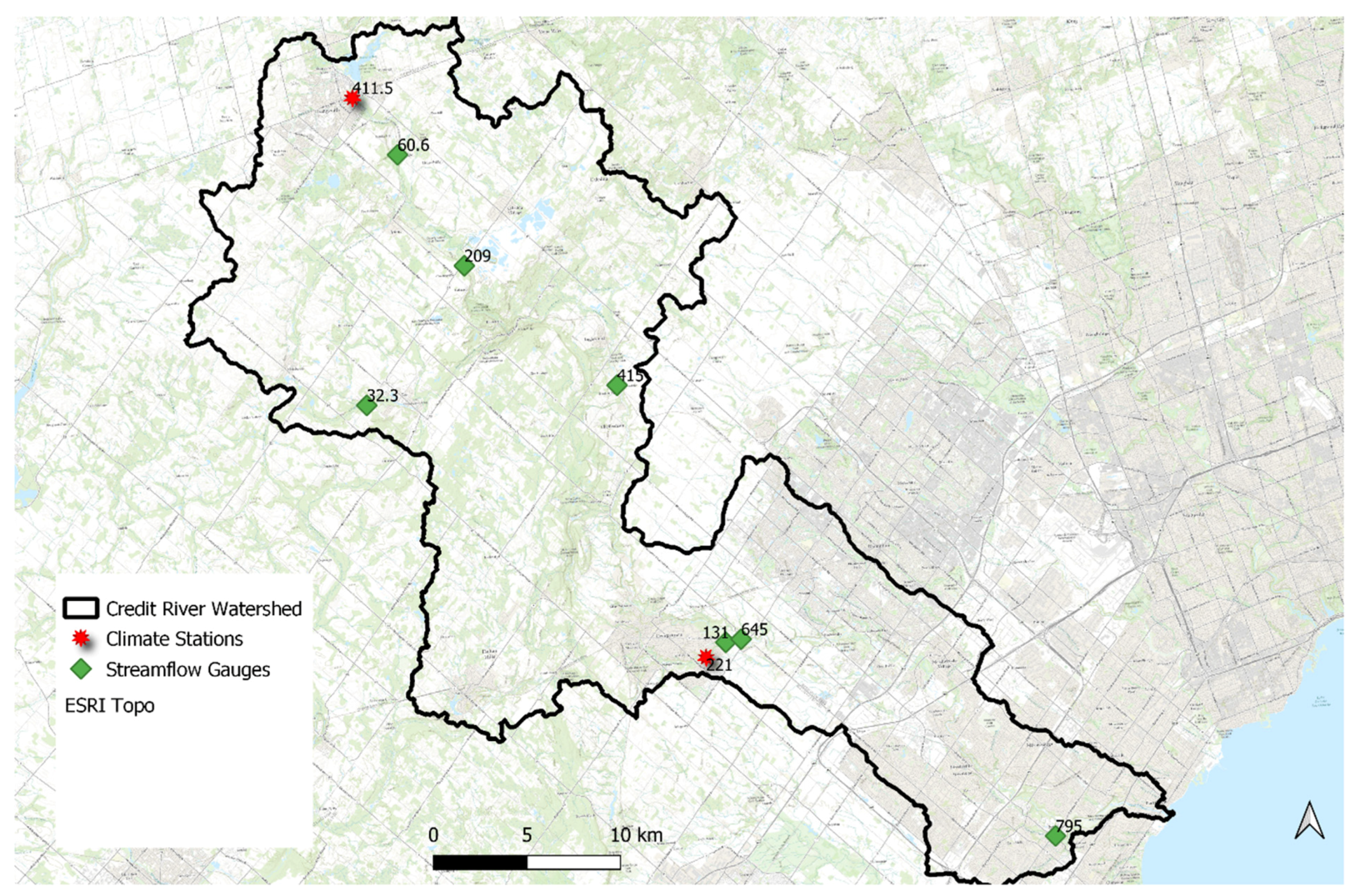

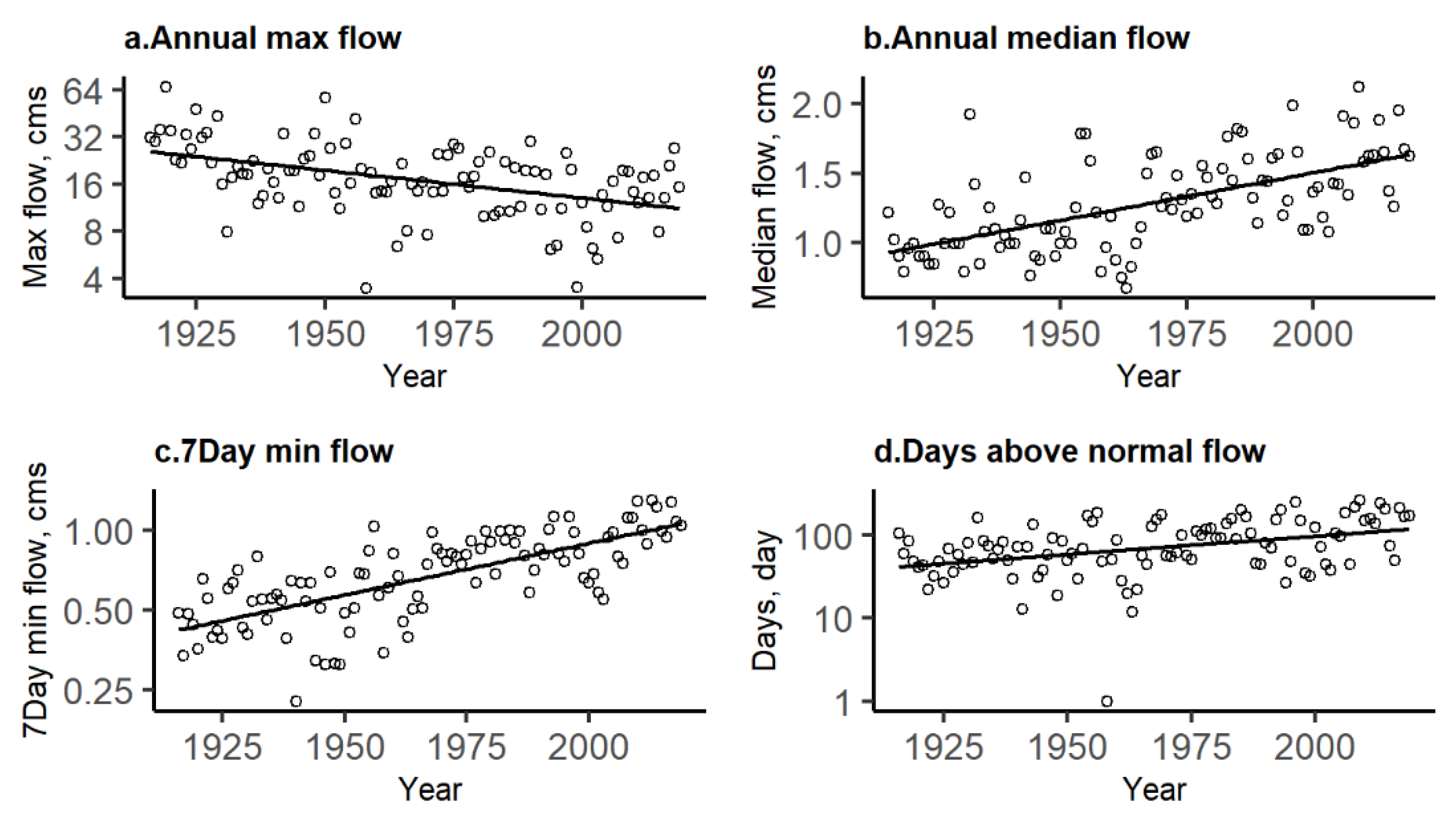

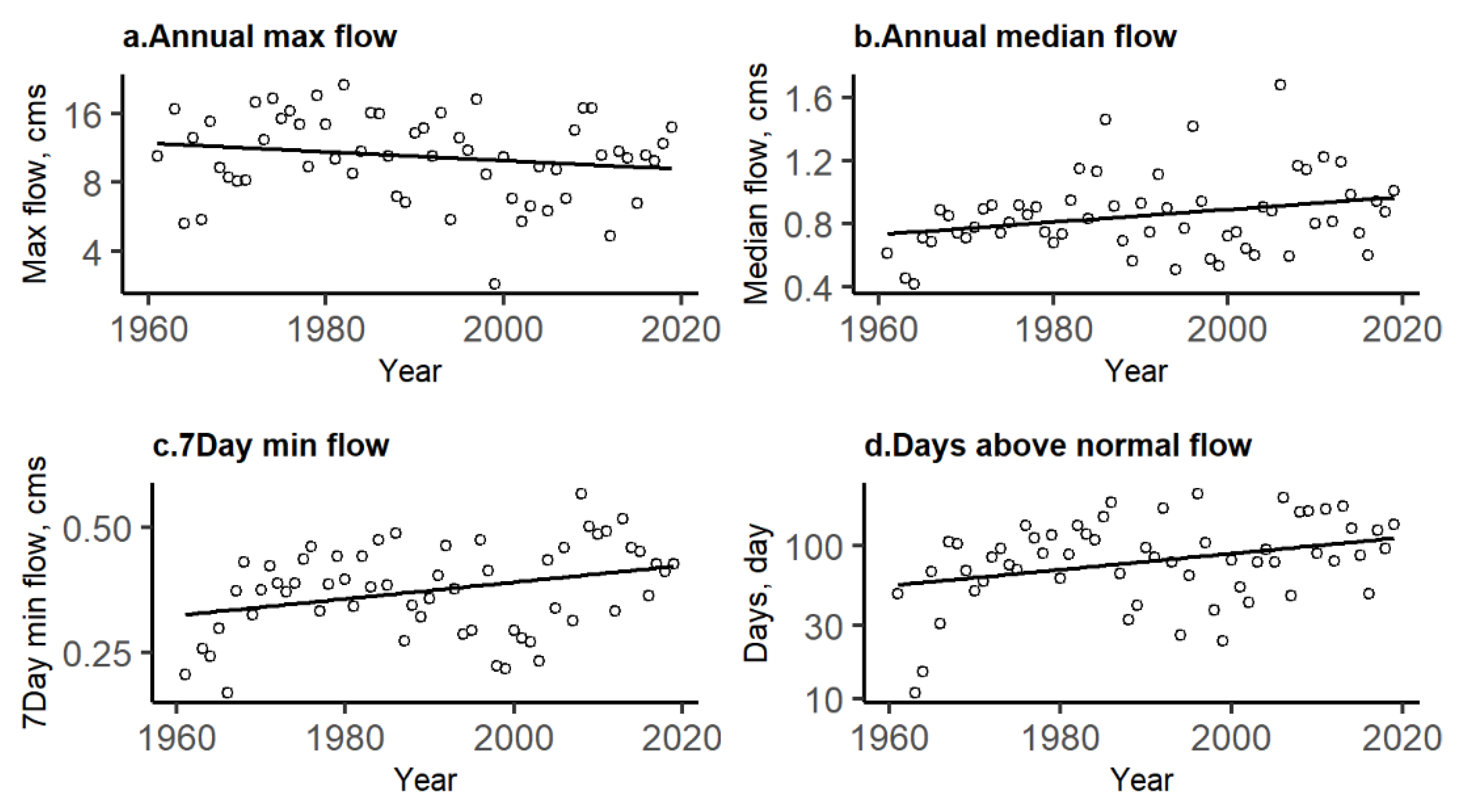
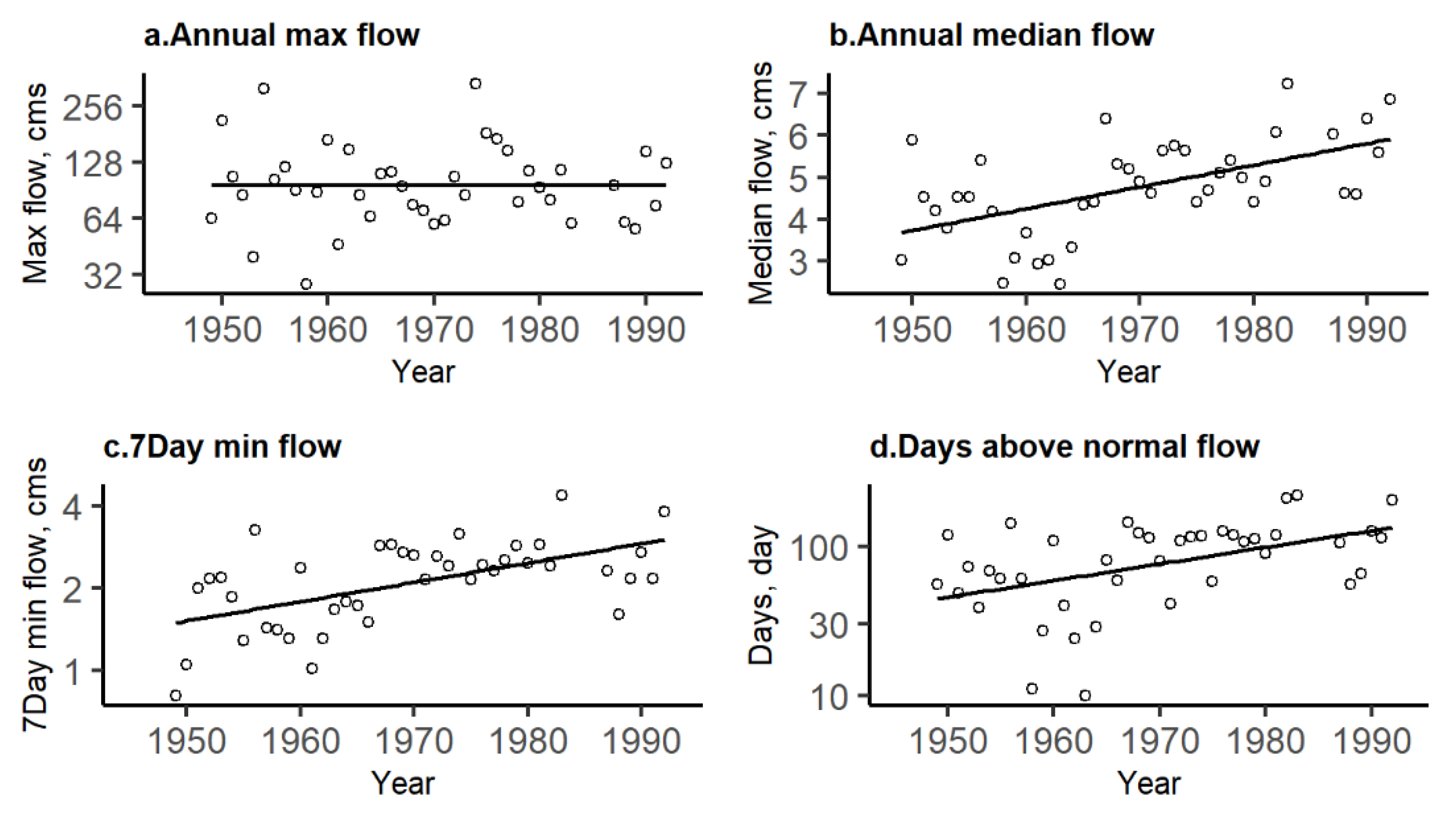




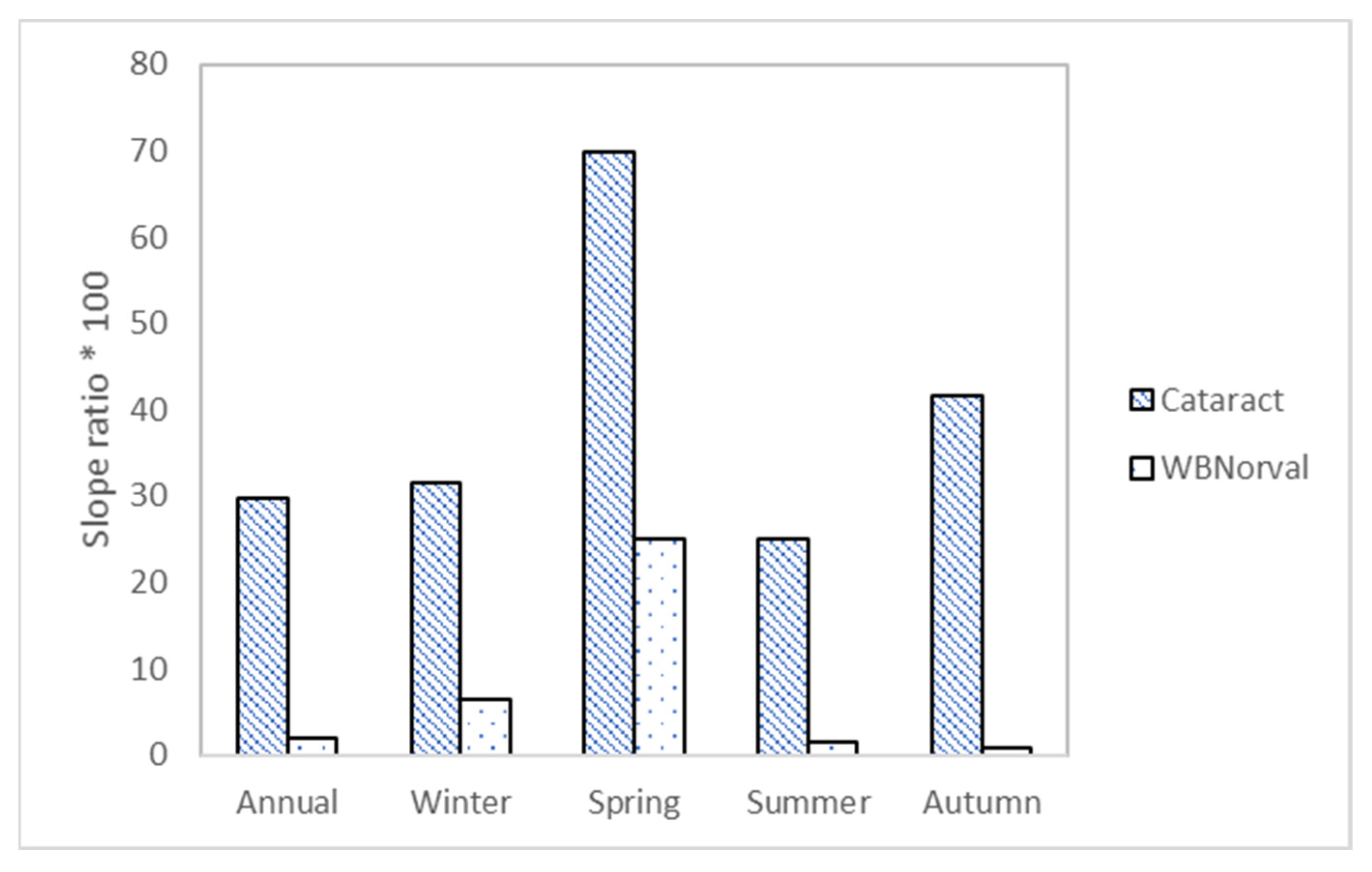
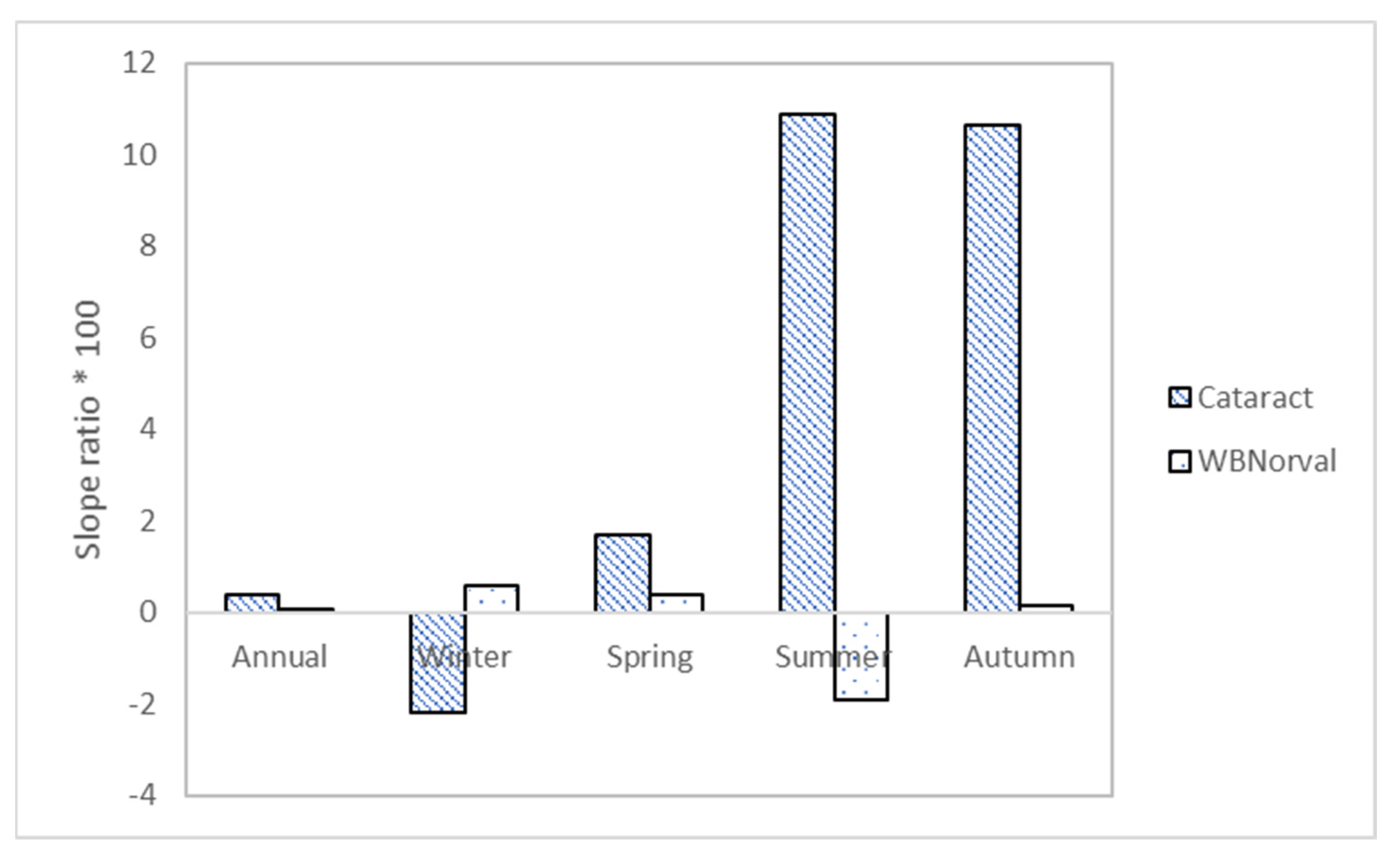

| Streamflow Gauge | Climate Gauge | Streamflow Gauge | Climate Gauge |
|---|---|---|---|
| Rural | Urban | ||
| Orangeville | Orangeville | WB Norval | Georgetown |
| Cataract | Orangeville | Erindale | Georgetown |
| Analysis | Parameters | |||||
|---|---|---|---|---|---|---|
| Meteorological | Hydrological | |||||
| Temperature | Precipitation | Evapotranspiration | Streamflow | Baseflow | Flow Duration Curve | |
| Annual/seasonal/monthly trend | ✓ | ✓ | ✓ | |||
| Annual/seasonal/sub-period trend | ✓ | ✓ | ||||
| Annual/seasonal/sub-period peak over threshold | ✓ | |||||
| Annual flood frequency | ✓ | |||||
| Annual low flow frequency | ✓ | |||||
| Annual/seasonal/sub-period runoff coefficient | ✓ | |||||
| Centre of volume trend | ✓ | |||||
| Annual/seasonal/sub-period baseflow index | ✓ | |||||
| Annual/seasonal/sub-period 10% exceedance | ✓ | |||||
| Annual/seasonal/sub-period 10:90 exceedance | ✓ | |||||
| Time | Temperature | Precipitation | Evapotranspiration | ||
|---|---|---|---|---|---|
| Orangeville | Georgetown | Orangeville | Georgetown | Watershed Average | |
| January | ↓ | ↑ | ↑↑ | ↑ | ↓↓ |
| February | ↑ | ↑↑ | ↑↑ | ↑ | ↓↓ |
| March | ↑ | ↓ | ↑ | ↑ | ↓ |
| April | ↑ | ↑ | ↑ | ↑ | ↑ |
| May | ↑ | ↑ | ↑↑ | ↑↑ | ↑↑ |
| June | ↑ | ↑↑ | ↑ | ↑ | ↑↑ |
| July | ↑ | ↑↑ | ↑ | ↑ | ↑ |
| August | ↑ | ↑↑ | ↓ | ↑ | ↑ |
| September | ↑↑ | ↑↑ | ↑ | ↑ | ↓ |
| October | ↓ | ↑↑ | ↑↑ | ↑ | ↓ |
| November | ↓ | ↑↑ | ↑↑ | ↑ | ↓↓ |
| December | ↑ | ↑↑ | ↑↑ | ↑ | ↓↓ |
| Winter | ↑↑ | ↑↑ | ↑↑ | ↑ | ↓↓ |
| Spring | ↑↑ | ↑↑ | ↑ | ↑↑ | ↑↑ |
| Summer | ↑↑ | ↑↑ | ↑ | ↓ | ↑ |
| Autumn | ↑ | ↑↑ | ↑↑ | ↑ | ↓ |
| Annual | ↑↑ | ↑↑ | ↑↑ | ↑↑ | ↑ |
| Gauge | Drainage Area (km2) | Period of Record (POR) | Chosen Sub-Period | ||||
|---|---|---|---|---|---|---|---|
| 1920–1939 (A) | 1940–1959 (B) | 1960–1979 (C) | 1980–1999 (D) | 2000–2019 (E) | |||
| Cataract (Rural) | 209 | 1916–2019 | ✓ | ✓ | ✓ | ✓ | ✓ |
| Erindale (Urban) | 795 | 1949–1993 | ✓ | ||||
| West Branch Norval (Urban) | 131 | 1961–2019 | ✓ | ✓ | ✓ | ||
| Orangeville (Rural) | 60.6 | 1968–2019 | ✓ | ✓ | |||
| Boston Mills (Rural) | 415 | 1983–2019 | ✓ | ||||
| Erin (Rural) | 32.3 | 1984–2019 | ✓ | ||||
| Norval (Urban) | 645 | 1989–2019 | ✓ | ||||
| Streamflow Trend | Baseflow Trend | |||||||||
|---|---|---|---|---|---|---|---|---|---|---|
| Period | ||||||||||
| A | B | C | D | E | A | B | C | D | E | |
| Annual | ||||||||||
| Cataract | ↑ | ↑ | ↑↑ | ↓ | ↑ | ↑ | ↑ | ↑↑ | ↓ | ↑ |
| Orangeville | ↓ | ↑↑ | ↓ | ↑↑ | ||||||
| Erindale | ↑↑ | ↑↑ | ||||||||
| WB Norval | ↑↑ | ↓ | ↑ | ↑↑ | ↓ | ↑ | ||||
| Winter | ||||||||||
| Cataract | ↑ | ↑ | ↑ | ↑ | ↑ | ↑↑ | ↑ | ↑ | ↑ | ↑ |
| Orangeville | ↓ | ↑↑ | ↓ | ↑↑ | ||||||
| Erindale | ↑↑ | ↑ | ||||||||
| WB Norval | ↑ | ↑ | ↑ | ↑ | ↓ | ↑ | ||||
| Spring | ||||||||||
| Cataract | ↑ | ↑ | ↑↑ | ↓ | ↑ | ↑ | ↑ | ↑↑ | ↓ | ↑ |
| Orangeville | ↑ | ↑↑ | ↑ | ↑↑ | ||||||
| Erindale | ↑ | ↑↑ | ||||||||
| WB Norval | ↑↑ | ↓ | ↑ | ↑↑ | ↑ | ↑ | ||||
| Summer | ||||||||||
| Cataract | ↓ | ↑ | ↑↑ | ↓ | ↑ | ↓ | ↑ | ↑↑ | ↓ | ↑↑ |
| Orangeville | ↓ | ↑↑ | ↓ | ↑↑ | ||||||
| Erindale | ↑↑ | ↑ | ||||||||
| WB Norval | ↑ | ↓ | ↑ | ↑ | ↓ | ↑ | ||||
| Autumn | ||||||||||
| Cataract | ↑ | ↑ | ↑↑ | ↓ | ↑ | ↑ | ↑ | ↑↑ | ↓ | ↑ |
| Orangeville | ↓↓ | ↑ | ↓ | ↑ | ||||||
| Erindale | ↑ | ↑↑ | ||||||||
| WB Norval | ↑ | ↑↑ | ↑ | ↑ | ↑↑ | ↑ | ||||
| Land Use | Percentage Area | |||
|---|---|---|---|---|
| 1956 | 1996 | 2010 | 2015 | |
| Natural area | 16.6 | 26.5 | 28.5 | 28.6 |
| Agricultural | 80.4 | 45.7 | 44 | 44.1 |
| Urban/settled area | 3 | 22.7 | 22.9 | 22.8 |
| Other | N/A | 1.5 | 4.6 | 4.5 |
| Time Period | Trending Parameter | ||||||
|---|---|---|---|---|---|---|---|
| Meteorological | Hydrological | ||||||
| Temperature | Precipitation | Evapotranspiration | Streamflow | ||||
| Orangeville | Georgetown | Orangeville | Georgetown | Watershed Average | Cataract | WB Norval | |
| Annual | ↑↑ | ↑↑ | ↑ | ↑ | ↑ | ↑↑ | ↑ |
| Winter | ↑↑ | ↑↑ | ↓ | ↑ | ↓ | ↑↑ | ↑ |
| Spring | ↑↑ | ↑↑ | ↑ | ↑ | ↑ | ↑↑ | ↑ |
| Summer | ↑↑ | ↑↑ | ↑ | ↓ | ↑ | ↑ | ↑ |
| Autumn | ↑ | ↑↑ | ↑ | ↑ | ↓ | ↑ | ↑ |
| Period | Cataract | WB Norval | % Change in BFI |
|---|---|---|---|
| Annual | 0.675 | 0.549 | 18.7 |
| Winter | 0.621 | 0.487 | 21.6 |
| Spring | 0.632 | 0.553 | 12.5 |
| Summer | 0.761 | 0.629 | 17.3 |
| Autumn | 0.743 | 0.592 | 20.3 |
Publisher’s Note: MDPI stays neutral with regard to jurisdictional claims in published maps and institutional affiliations. |
© 2022 by the authors. Licensee MDPI, Basel, Switzerland. This article is an open access article distributed under the terms and conditions of the Creative Commons Attribution (CC BY) license (https://creativecommons.org/licenses/by/4.0/).
Share and Cite
Philip, E.; Rudra, R.P.; Goel, P.K.; Ahmed, S.I. Investigation of the Long-Term Trends in the Streamflow Due to Climate Change and Urbanization for a Great Lakes Watershed. Atmosphere 2022, 13, 225. https://doi.org/10.3390/atmos13020225
Philip E, Rudra RP, Goel PK, Ahmed SI. Investigation of the Long-Term Trends in the Streamflow Due to Climate Change and Urbanization for a Great Lakes Watershed. Atmosphere. 2022; 13(2):225. https://doi.org/10.3390/atmos13020225
Chicago/Turabian StylePhilip, Elizabeth, Ramesh P. Rudra, Pradeep K. Goel, and Syed I. Ahmed. 2022. "Investigation of the Long-Term Trends in the Streamflow Due to Climate Change and Urbanization for a Great Lakes Watershed" Atmosphere 13, no. 2: 225. https://doi.org/10.3390/atmos13020225
APA StylePhilip, E., Rudra, R. P., Goel, P. K., & Ahmed, S. I. (2022). Investigation of the Long-Term Trends in the Streamflow Due to Climate Change and Urbanization for a Great Lakes Watershed. Atmosphere, 13(2), 225. https://doi.org/10.3390/atmos13020225






